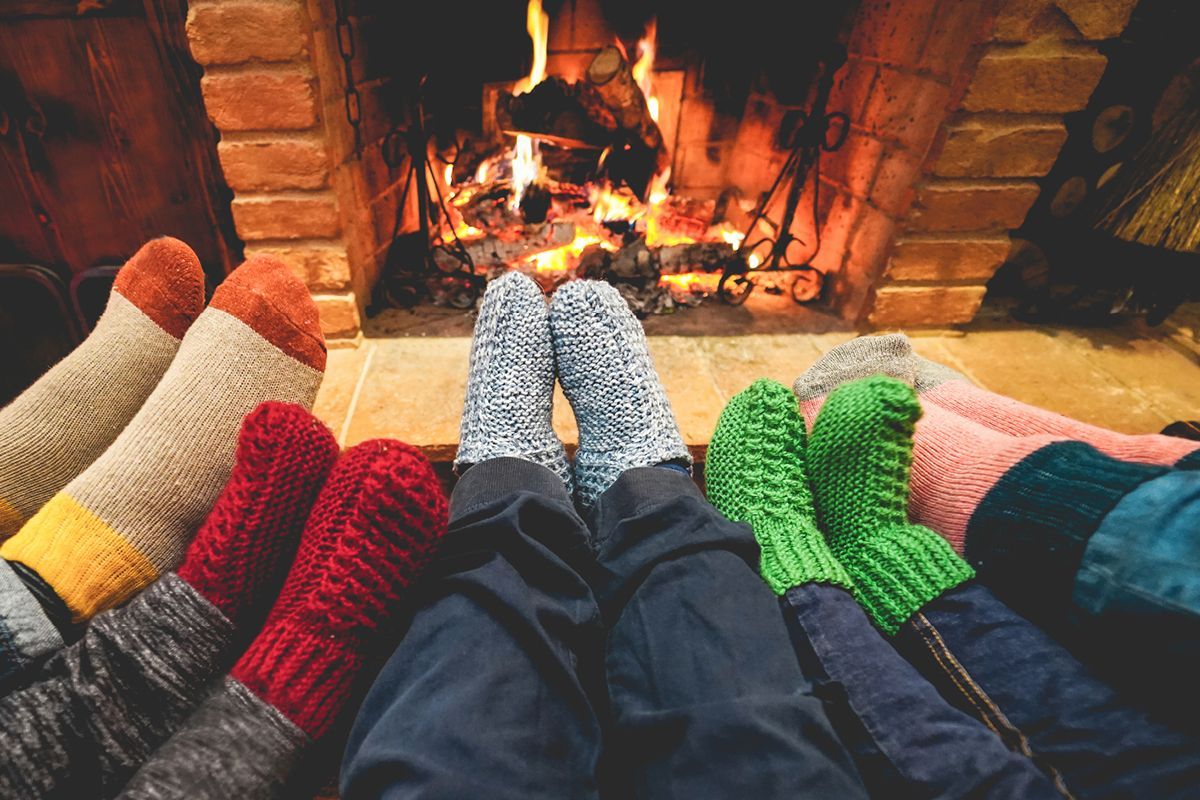Preparing Your Home for a Warm and Cozy Winter
As the days grow shorter and the air becomes crisper, the arrival of winter prompts us to shift our focus to keeping our homes warm and comfortable.

Preparing your heating source for the cold months ahead is essential to ensure that you and your loved ones stay snug indoors. In this article, we’ll explore key steps to get your heating system ready for a cozy and worry-free winter season.
Schedule an Inspection
Schedule an Inspection
Consider having your heating system inspected by a professional. A licensed technician can identify any potential issues and perform necessary maintenance to ensure your heating source operates efficiently throughout the winter. Whether you rely on a furnace, heat pump, or another heating system, a thorough inspection can save you from breakdowns on the coldest days.
Change Air Filters
Clean air filters are crucial for optimal heating system performance. Dirty or clogged filters can restrict airflow, making your heating system work harder and potentially reducing its efficiency. Replace air filters according to the manufacturer’s recommendations or at least once every three months. This not only enhances indoor air quality but also promotes smoother heating.
Stock Up on Fuel
For those with heating systems that rely on fuel, such as oil or propane, make sure you have an adequate supply for the winter months. Stock up early to avoid any supply shortages or price hikes that can occur during peak winter demand. Regularly monitor your fuel levels throughout the season to ensure you don’t run out unexpectedly.
Clean and Clear Vents and Ducts
Take the time to clean and clear heating vents and ducts from dust, debris, and obstructions. Blocked vents can hinder proper airflow, leading to uneven heating in your home. Vacuum or dust vents, and consider hiring a professional to clean your ducts if you suspect a significant buildup of dirt and debris.
Test the Thermostat
Ensure your thermostat is functioning correctly by testing it before the winter season begins. Adjust the settings to see if the heating system responds accordingly. If you have a programmable thermostat, consider programming it to optimize energy savings by lowering the temperature when you’re away and raising it when you’re home.
Seal Drafts and Insulate
To maximize the efficiency of your heating system, ensure that your home is properly insulated and sealed against drafts. Check for gaps around windows and doors and use weather stripping or caulk to seal any openings. This prevents warm air from escaping and cold air from seeping in, reducing the workload on your heating system.
Prepare Backup Heating Options
In case of unexpected heating system issues, having backup heating options can provide peace of mind. Portable space heaters, electric blankets, and heated throws can offer temporary warmth while you address any heating system repairs.
Educate Your Household
Educate your household members about how to operate the heating system efficiently. Encourage everyone to set the thermostat to a comfortable yet energy-saving temperature, and remind them to dress warmly indoors to reduce the need for excessive heating.
Consider a Smart Thermostat
If you’re looking to enhance control and energy efficiency, consider investing in a smart thermostat. These devices allow you to remotely control your heating system using a smartphone app. Some models even learn your preferences and adjust the temperature accordingly, optimizing co
By taking these proactive steps, you’ll ensure that your heating source is ready to provide consistent warmth and comfort throughout the winter. A well-prepared heating system not only keeps you cozy but helps lower energy costs and a more sustainable and eco-friendly home environment.

“After trying for a child for 3 years, we found out that it was not possible for us naturally, as fate would have it we were asked to adopt Zeke 2 months later. From that moment on Zeke became our world. We got to name him and be there for the birth and took custody when he was a month old. Zeke just turned 4 in November. We knew there was a chance he would be diagnosed with neurofibromatosis type 1 (NF1) and he was at 3 months old. This condition for him has mostly manifested as what is called cafe au lait spots (think lots of large freckles) but can cause tumours anywhere along his nervous system so he is monitored. In November of 2023 he started getting sick; throwing up and lethargic one day and fine the next but it was assumed to be typical sicknesses (colds, flu, etc.) from being in pre-primary. Then on the 24th after a bout of vomiting, he lost consciousness and was rushed to the hospital via EHS. Once there he was found to have an ear infection and they assumed he’d had a febrile seizure, then 6 days later it happened again. This time the ear infection was gone and so the doctor started looking for other causes, finding a CT from March which revealed he had a glioma that we had not been made aware of by anyone. The seizures then happened again that night, so the doctor got to see it from start to finish. At this point I went off work on a stress leave so one of us was always available to be with Zeke or pick him up from school because he couldn’t stay to the end most days, he was exhausted. Our pediatrician became very concerned and contacted the IWK, trying to rush an MRI and promised we’d have one by the end of December no matter what it took. The third time it happened was Dec 5th, when we once again headed to Valley Regional. This time however we were told because nothing was “abnormal” with his breathing, heart rate, blood work, or blood pressure to not come in unless it developed into something abnormal because until the IWK did testing there was nothing they could or would do. In total we spoke to 5 doctors who concern ranged from “this is really serious” to “he’s a kid. kids get sick so don’t worry.” On Dec 20th at Noon, he had his MRI, then at 5:30pm that day his pediatrician called us to bring him back the next morning to be admitted because he needed surgery. Zeke was diagnosed with a diffused brain tumour and hydrocephalus. His fourth ventricle had been completely blocked and the pressure from the fluid was causing his sickness and seizures. On Dec 22nd he had two brain surgeries, one for the fluid on his brain from the hydrocephalus, and one to removed pieces of the tumour to relieve most of the pressure. The problem we faced then is that where his tumour was diffused, they couldn’t cut much of it out without risking brain damage, as It has tentacles burrowing through parts his brain almost like roots of a plant. On January 16th this year he had surgery to have a Port-a-Cath implanted and he started his Chemotherapy on January 17th. Currently the plan is that he will be doing Chemo weekly for 15 months, if it is successful, we will still have to monitor the tumour for the rest of his life to ensure it doesn’t start growing again. With everything that’s been going on I’ve taken a leave from work to take care of him, while my husband remains working Fulltime. “ How YOU can help! There is a Facebook group called Zeke’s Support Squad . His mum can be emailed at c_sweeney@yahoo.com. There is a GoFundMe link www.gofundme.com/f/our-amazing-boy-zeke-needs-your-help Different places tat are accepting donations including Bridgetown Pharmasave, Bridgetown Variety Store, The Perky Loaf, Bee’s Knees General Store and Bakery , Lawrencetown PharmaChoice and aRoma mocha café, DiValerio’s Sweets & Savories, Rockin Rogis, and Sobey’s in Windsor.

Buckle up as we explore the twists and turns of the car-buying journey and help you decide whether to hit the dealership for a fresh set of keys or take the backroads in search of a trusty companion with a bit of history. 1. Budget: Picture this: you’ve got your eye on that sleek new model, but your bank account is giving you side-eye. The first pit stop in our journey is your budget. New cars might come with that enticing new car smell, but they can also come with a hefty price tag. Used cars, on the other hand, can be the budget-friendly alternative, allowing you to get more bang for your buck. It’s all about finding the sweet spot where your wallet and desires meet. 2. Depreciation: Hold on tight as we navigate the twisty roads of depreciation. New cars take the steepest plunge in value during the first few years. It’s like driving off a financial cliff! Used cars, having weathered the initial depreciation, offer a more stable investment. Let’s face it – nobody likes losing money, especially when it comes to something as significant as your ride. 3. Insurance Costs: Time to talk about everyone’s favorite topic – insurance. New cars often come with higher insurance premiums, thanks to their shiny price tags and potentially expensive repair costs. Used cars, being a bit more seasoned, might come with friendlier insurance rates. So, not only do you save on the purchase, but you might catch a break on insurance too. Now, that’s a win-win. Advantages of Buying a New Car: 1. Latest Features and Technology: New cars are like the James Bond of the road – equipped with cutting-edge technology and safety features. From adaptive cruise control to parking assist, you’re in for a tech-fueled joyride. Plus, the satisfaction of being the first to experience that new car smell – priceless! 2. Warranty Coverage: Worried about unexpected breakdowns putting a dent in your wallet? Fear not! New cars come with the golden ticket – a warranty. Drive worry-free, knowing that most repairs are covered for the first few years. It’s like having a safety net for your four-wheeled friend. Advantages of Buying a Used Car: 1. Cost Savings: Let’s talk numbers. Used cars bring cost-saving mojo to the table. For the same budget, you could snag a higher trim level or a fancier model. It’s like upgrading to first class without breaking the bank. Your wallet will thank you, and you’ll still roll up in style. 2. Certified Pre-Owned Programs: Not ready to fully commit to the used car world? Enter the Certified Pre-Owned (CPO) program. It’s like the VIP pass of the used car market. These cars undergo rigorous inspections, come with extended warranties, and offer a middle ground between new and used. Peace of mind? Check. As our journey through the twists and turns of new vs. used car buying comes to an end, the choice is yours – rev up for the shiny allure of a new ride or roll back into the comfort of a seasoned companion. Whatever path you choose, make sure it aligns with your budget, preferences, and the thrill of the open road. Ready to make that decision? The adventure begins now! Happy driving!

1. Clarity of Vision: Imagine setting out on a road trip without a map or destination in mind. Define the purpose of the renovation, establish your goals, and visualize the end result. This clarity becomes your guiding star throughout the project, ensuring every decision aligns with your ultimate vision. 2. Budget Management: One of the most critical aspects of any renovation is staying within budget. Planning allows you to set a realistic budget based on your vision, priorities, and available resources. It’s your chance to break down costs, identify potential areas of overspending, and allocate funds wisely. With a well-thought-out plan, you can prevent financial headaches and ensure that your dream renovation doesn’t turn into a financial nightmare. 3. Timely Execution: Time is money, especially in the realm of renovation. Planning not only helps you allocate time efficiently but also establishes a realistic timeline for the project. Consider the order of tasks, potential delays, and the overall duration of the renovation. A well-structured plan minimizes downtime, keeps the project on track, and ensures that you’re not camping out in a construction zone longer than necessary. 4. Efficient Resource Utilization: Every renovation project involves a multitude of resources, from materials to manpower. Planning allows you to optimize the use of these resources. Identify the materials needed, explore eco-friendly options, and schedule labor according to project milestones. This efficiency not only contributes to cost-effectiveness but also minimizes waste, aligning your renovation with sustainable practices. 5. Anticipating Challenges: Renovations often come with surprises – some welcome, others not so much. Through comprehensive planning, you can anticipate potential challenges and devise strategies to overcome them. Whether it’s uncovering hidden structural issues or dealing with unexpected permit delays, a well-prepared plan equips you to navigate hurdles with resilience and agility. 6. Regulatory Compliance: Navigating the regulatory landscape is a critical aspect of any renovation. From building permits to zoning regulations, understanding and complying with local laws is essential. Planning provides the opportunity to research and address these regulatory requirements in advance, preventing legal roadblocks that could halt or complicate your project. In the world of renovation projects, planning is the unsung hero that turns dreams into reality. It brings order to chaos, transforms visions into tangible blueprints, and ensures that your investment – whether in time, money, or effort – yields the desired outcome. So, before you don your hard hat and reach for the toolbox, take the time to plan meticulously. Your dream home awaits, and a well-crafted plan is the key to unlocking its full potential. Happy renovating!

In an exciting move to enhance community support, Valley Credit Union proudly announces, starting February 5, 2024, they will be open 5 days a week from 10 AM to 4 PM! This change was driven by community feedback and aims to address the evolving financial needs of Bridgetown and surrounding residents. The decision was announced at a community meeting on November 14, 2023, by President and CEO, Leigh Doucette in response to concerns raised about the impact of big bank closures in the area. Extended Hours for Your Convenience Mark your calendars! Valley Credit Union’s Bridgetown and Middleton branches will be hosting an open house from February 5-9, 2024 from 10 AM to 4 PM each day. These extended hours are designed to align with other branches and to enhance accessibility, ensuring you can access banking services locally at your convenience. Valley Credit Union also offers online appointments. You can book a meeting to talk to an expert by phone or video conference if going into the branch is not convenient for your busy schedule. Community Over Profits Valley Credit Union is not just about banking; it’s about community impact. Every deposit you make stays within the community, supporting the local economy, job creation, and fostering a better financial future for everyone. Anyone can join a credit union and the common share is only $5. Services Offered Valley Credit Union offers a comprehensive suite of financial services supporting your personal financial journey or business needs. Some of the products they offer are; mortgages, loans, credit cards, POS merchant solutions, student loans, saving & investment planning and a full suite of digital banking solutions. How to Make the “switch” Transitioning to Valley Credit Union is easy! There is a list of what you would need to prepare posted on their website. You can open an account online then book an appointment to go over all your goals and work with an expert to find the solution right for you. Now is the perfect time to join Valley Credit Union - Embrace the convenience, embrace the community, and let Valley Credit Union be your financial home! Middleton Branch: 301 Main Street, Middleton - 902-825-6876 Bridgetown Branch: 256 Granville St, Bridgetown - 902-665-2545

Enhancing Cancer Care Valley Regional Hospital Foundation is set to benefit significantly from the Fraser’s Paint Project, as the funds raised will specifically support the acquisition of five cystoscopes for the hospital's Operation Rooms in the Surgical Unit. A cystoscope is a crucial medical optical instrument that enables urologists to obtain detailed images of the bladder and urethra. This technology will play a pivotal role in enhancing pre-screening, early detection, and treatment of bladder and prostate cancer at Valley Regional Hospital. $1 per Gallon Paint Purchase Fraser's Pro Home Centre, with five locations across the Annapolis Valley in Berwick, Kingston, Kentville, Annapolis Royal, and Bridgetown , is making a substantial contribution to this cause. For every gallon of paint purchased from Fraser's Pro Home Centre's locations, $1 from each sale directly supports early detection and cancer treatment at Valley Regional Hospital. Goal to Raise $100,000 This collaboration is not a one-time effort; Fraser's Pro Home Centre has committed to a three-year partnership with the Foundation. The overarching goal is to raise $100,000, ensuring the acquisition of the much-needed five cystoscopes. These scopes are indispensable, providing state-of-the-art equipment to deliver the highest level of care to patients facing bladder and prostate cancer. Fraser’s Pro Home Centre commitment is part of the Foundation’s larger Operation Enhancement Campaign, where the goal is to raise over $2 million to refurbish the Operating Rooms at Valley Regional Hospital. Cystoscopes are part of the equipment needed for this larger project. Empowering Urologists, Enhancing Patient Care The impact of this partnership extends beyond monetary contributions by supporting the purchase of cystoscopes, This translates to improved diagnostic capabilities, quicker intervention through early detection, and enhanced treatment options for individuals facing bladder and prostate cancer. A Shared Commitment to Community Health Fraser's Pro Home Centre and Valley Regional Hospital Foundation's collaboration exemplifies the powerful impact that businesses and healthcare institutions can achieve when working together. This initiative not only highlights the commitment of Fraser's Pro Home Centre to community well-being but also the Foundation's dedication to healthcare services for the Annapolis Valley residents. Fraser's Paint Project stands as a shining example of how a local business and a healthcare foundation can unite for a common cause. Through the sale of paint, Fraser's Pro Home Centre is contributing to the improvement of cancer care at Valley Regional Hospital, making a lasting impact on the health and well-being of the community.

Ingredients 125g butter 250g dates, stoned 125ml boiling water 1 tsp vanilla extract 275g brown sugar 325ml whipping cream 5 tbsp molases 2 large eggs, beaten 200g self-raising flour 1 tsp bicarbonate of soda Pinch of sea salt Clotted cream, custard or ice cream to serve. Prepare Slow Cooker: Preheat your slow cooker on low for 10 minutes. Ensure your pudding bowl fits snugly with the lid closed. Grease the bowl with 1 tbsp of butter and line it with baking paper. Date Soaking: Place the dates in a heatproof bowl, covering them with boiling water. Let them soak for 30 minutes. Create Toffee Sauce Base: In a pan, combine vanilla extract, 80g of brown sugar, whipping cream, half the molasses, and half the butter. Cook over medium heat, stirring until the sugar dissolves. Increase the heat and cook for an additional 3 minutes. Whisk the mixture, add a pinch of sea salt, and pour about a third into the lined bowl, reserving the rest for later. Prepare Date Pudding Batter: Remove dates from the bowl, chop them, and reserve the soaking water. In a mixing bowl, combine the remaining brown sugar, molasses, and butter with beaten eggs. Fold in flour, bicarbonate of soda, ¼ tsp of sea salt, chopped dates, and the soaking water. Spoon the batter into the pudding bowl, leaving a 1cm gap at the top. Cover with greased baking paper and tin foil, making a central cut for steam, and tie with string. Slow Cooking Magic: Place the bowl in the slow cooker, pour boiling water halfway up the side of the bowl, and close the lid. Cook on low for 8 hours. Finishing Touch: Carefully remove the pudding and turn it onto a serving plate. Reheat the reserved toffee sauce and pour it over the pudding. Serve this indulgent delight with a dollop of clotted cream, custard, or a scoop of your favorite ice cream.

The post-holiday season can be financially challenging, making it a crucial time for both donating to and reaching out for assistance from local food banks. In our catchment area, several organizations extend a helping hand, ensuring that no one goes hungry during the winter months. Donating to Food Banks: An Act of Kindness After the generosity of the holiday season, January is an opportune time to pay it forward by supporting local food banks. The importance of these donations cannot be overstated, as they contribute to the well-being of our neighbors and strengthen the fabric of our communities. Here’s why donating to food banks in January is a meaningful endeavor: Meeting Ongoing Needs: While the holiday season sees increased donations, the need for food assistance continues well into the new year. Your contributions in January help sustain food bank resources, ensuring a consistent supply for those in need. Addressing Winter Challenges: January in Nova Scotia often brings harsh weather conditions. Donations of non-perishable items and essentials become even more critical, providing warmth and nourishment to those facing the winter cold. Encouraging Year-Round Support: By promoting donations in January, we encourage a culture of year-round giving. Food banks operate consistently, and ongoing community support is vital to their mission of alleviating hunger. Supporting Local Initiatives: Local food banks tailor their support to the specific needs of their communities. Your January donations contribute to these localized efforts, making a direct impact on individuals and families in our catchment area. Reaching Out for Assistance: A Sign of Strength If the post-holiday season brings financial challenges, it’s important to recognize that reaching out for assistance from food banks is an act of courage and strength. Food banks are here to provide support, and seeking help ensures that you and your family have access to the nourishment you need. Here’s why reaching out in January is crucial: Navigating Post-Holiday Pressures: January often brings financial pressures as bills from the festive season arrive. Food banks offer a helping hand, ensuring that individuals and families can focus on essential needs without worrying about putting food on the table. Maintaining Dignity: Food banks operate with the utmost respect for the dignity of those seeking assistance. By reaching out, you prioritize your well-being and that of your loved ones, fostering a community that cares for each other. Utilizing Available Resources: Food banks are equipped to support community members during challenging times. Your local food bank has resources in place to ensure that you receive the assistance you need, whether it’s a temporary measure or ongoing support. Building Connections: Reaching out to a local food bank establishes a connection within the community. It opens the door to additional resources, information, and support that may be available to you and your family. Local Food Banks: Locations and Hours Here are some of the local food banks ready to provide support: Annapolis Area Food Bank Annapolis Royal Regional Academy, 590 St George Street, B0S 1A0 Phone: (902) 532-5572 Hours: 6pm-8pm second and third Wednesday of each month. Bridgetown and Area Food Bank #8 Albert Street , Bridgetown B0S 1C0 Phone: 902-665-2858 Hours: 4pm-7pm second Wednesday of the month and 9am-11am third Wednesday of the month. Digby and Area Food Bank 53 Mount Street, Digby B0V 1A0 Phone: 902-378-4508 Hours: Call for hours Twelve Baskets Food Bank 9326 Highway 10, Nictaux NS B0S 1P0 Phone: 902-825-3966 Hours: Monday: 1pm - 3pm Wednesday: 6pm - 8:30pm Friday: 9am - 11:30am Upper Room Food Bank Association 669 Main St., Kingston, NS B0P 1R0 Phone: (902) 765-0303 Hours: Monday 9am - 12pm, Thursday 6pm - 9pm

In our previous issue, we discussed the essential steps for winter storm preparedness, focusing on safeguarding our homes from the anticipated challenges of snow, ice, and strong winds. Now that the storm has passed, it’s crucial to address the aftermath and specifically consider the impact on trees around our properties. The accumulation of snow and ice, coupled with powerful winds, can turn trees into potential hazards, posing risks to property, power lines, and community safety. Assessing the Damage: After a severe winter storm, the first step is to assess the damage. Take a careful look around your property and identify any fallen branches, damaged trees, or potential hazards. Keep safety in mind, and if you’re unsure about the stability of a tree or branch, it’s best to seek a professional. Immediate Safety Measures: If you notice any immediate safety concerns, such as a fallen tree blocking a road or a precarious branch hanging over a power line, contact local authorities or utility companies immediately. Safety should be the top priority, and addressing urgent issues promptly can prevent further damage and ensure the well-being of the community. Professional Arborist Evaluation: Engaging the services of a professional arborist becomes especially crucial after a storm. Experts are trained to assess the health and stability of trees, identifying hidden risks that may have emerged during the storm. Whether it’s removing broken branches, strategically pruning damaged areas, or recommending the removal of severely compromised trees, their expertise is invaluable in restoring safety to your property. Power Line Clearance: If the storm has caused tree branches to interfere with power lines, it’s essential to address this issue promptly. Certified arborists with experience in utility line clearance can safely trim and prune trees to prevent further disruptions to the power grid. By doing so, we not only protect our homes but also contribute to the overall reliability of the community’s power supply. Tree Risk Assessment: A comprehensive tree risk assessment can help identify potential hazards that may not be immediately apparent. Arborists can evaluate the stability of trees, recommend necessary actions, and create a plan to mitigate future risks. This proactive approach ensures the long-term health of the trees and minimizes the likelihood of damage in subsequent storms. Community Collaboration: As we collectively recover from the winter storm, it’s essential to encourage community collaboration. Share information about reputable arborists and tree care services, fostering a sense of shared responsibility for maintaining the safety and aesthetics of our neighborhoods. A resilient community is one that looks out for each other, especially in the face of natural challenges. In the aftermath of a winter storm, taking prompt and informed action is crucial to protect your property and contribute to the well-being of the community. By assessing damage, prioritizing safety, engaging professional arborist services, addressing power line concerns, conducting tree risk assessments, and fostering community collaboration, we can navigate the aftermath of the storm with confidence. Remember, the investment in safeguarding our trees is an investment in the safety and resilience of our homes and community.

1. Cold-Weather Challenges: Nova Scotia experiences cold and snowy winters, and the conditions can be harsh on your vehicle. Before winter sets in, it’s essential to perform a thorough check to ensure your vehicle is ready for the challenges ahead. 2. Tire Inspection: Your tires are your first line of defense on snowy and icy roads. Check the tread depth and ensure your tires are properly inflated. Consider switching to winter tires for enhanced traction in cold conditions, a must for navigating Nova Scotia’s winter terrain. 3. Battery Health: Cold weather can be tough on car batteries. Ensure your battery is in good condition, and if it’s more than a few years old, consider having it tested or replaced. A reliable battery is crucial for starting your vehicle in low temperatures. 4. Fluid Levels: Check all fluid levels, including oil, coolant, and windshield washer fluid. Ensure that your antifreeze mixture is appropriate for winter temperatures. Keeping your fluids at the right levels helps your vehicle operate efficiently in colder weather. 5. Brake Inspection: Winter driving requires responsive brakes. Have your brakes inspected to ensure they are in good working order. Address any issues promptly to maintain optimal braking performance. 6. Lights and Visibility: Days are shorter in winter, and visibility is often reduced. Ensure all lights, including headlights, taillights, and turn signals, are working properly. Keep your windshield washer reservoir filled with winter-grade fluid, and replace windshield wipers if they are worn. 7. Emergency Kit: Prepare for the unexpected by having an emergency kit in your vehicle. Include items such as a blanket, flashlight, jumper cables, a shovel, and non-perishable snacks. Being prepared can make a significant difference in case of an emergency. 8. Drive Safely: Even with a well-maintained vehicle, adjusting your driving habits is crucial in winter conditions. Reduce your speed, increase following distance, and avoid sudden movements. Nova Scotia’s winter roads can be unpredictable, so cautious driving is key. 9. Regular Maintenance: Don’t overlook regular maintenance tasks. Keeping up with scheduled maintenance, such as oil changes and filter replacements, ensures your vehicle is operating at its best, even in challenging winter conditions. Where winter driving conditions can be unpredictable, taking the time to check over your vehicle is a responsible and safety-conscious approach. By following these steps, you can enhance your vehicle’s performance and increase your safety on the winter roads of Nova Scotia. Stay safe and enjoy the winter season!

Understanding Your Surroundings: Nova Scotia’s picturesque landscapes, with its coastal beauty and lush greenery, can serve as inspiration for your home’s color palette. Consider incorporating earthy tones like ocean blues, forest greens, and sandy beiges to seamlessly blend with the natural environment. Architectural Style Matters: Take a moment to evaluate the architectural style of your home. Traditional homes might benefit from classic, timeless colors, while modern structures may lend themselves to bold and contemporary palettes. As a local magazine based in Nova Scotia, we appreciate the diverse architectural styles found in the region, from charming heritage homes to sleek, modern designs. Harmony with the Interior: Achieving a cohesive look throughout your home involves considering not only the exterior but also the interior color scheme. Create a seamless transition by selecting colors that complement each other, ensuring a harmonious flow from room to room. Weather Considerations: In Nova Scotia, where weather conditions can vary, it’s essential to choose colors that withstand the elements. Durable and weather-resistant paint will help maintain the vibrancy of your chosen palette, whether facing the salty sea breeze or the occasional snowfall. Community Aesthetics: Being a part of the Nova Scotia community means contributing to the local aesthetics. While expressing your personal style is important, it’s also valuable to consider how your home fits into the broader neighborhood. Opting for colors that harmonize with the local architectural character can enhance the overall appeal. Testing and Sampling: Before committing to a color palette, it’s advisable to test and sample different shades. Nova Scotia’s unique lighting conditions can significantly impact how colors appear. Take advantage of paint samples and observe how they look during different times of the day to ensure they meet your expectations. Personal Expression: Ultimately, your home is a reflection of your personality and style. Don’t be afraid to inject a bit of your own flair into the color selection process. Whether it’s a vibrant door or a subtle trim, incorporating personal touches adds character and uniqueness to your home. In conclusion, picking the right color palette for your Nova Scotia home involves a thoughtful blend of inspiration from the local environment, consideration of architectural style, harmony with the interior, resilience to weather conditions, awareness of community aesthetics, and a touch of personal expression. By carefully navigating these factors, you can create a visually appealing and welcoming home that truly stands out in the beautiful landscape of Nova Scotia.

